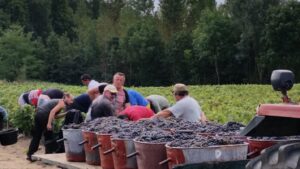For most of us, wine tasting is focused on, well, wine. We visit different wineries in the same region and learn to detect the subtle differences between one Chardonnay and, say, three others made within a mile of one another. We give credit, if we think about it at all, to the winemaker who we see as a master artisan. In general that’s true, but wine is a combination of artistry, industrial processes and agriculture.
Even when we are at a winery surrounded by vines, how many of us even consider soil composition, trellising and drip irrigation? Visiting at harvest time, with grapes hanging heavy on the vines, we don’t believe that many people give a lot of thought to how much science, expertise and sheer hard work went into getting those grapes there. Now, we’re not advocating that everyone take a few courses at Davis before going wine tasting, but maybe a few thoughts on the matter and a bit of reading are appropriate.
Workers harvesting in the Beuajolais region.
You’ll enjoy the wine you taste at any time of the year, but we think that there’s also pleasure in knowing what has to happen to get the wine out of the ground and into your glass. For one thing, a visitor ought to be aware of what’s happening in the vineyards at any particular time of year that they are there. Of course, in the winter months the vines are bare, but there’s lots of work going on to prune the vines to increase later yields. In March, there’s some green on those vines; it’s called bud break. Sometime in May, itsy-bitsy grapes begin to form, which is called the fruit set.
Things get serious in July and August, the period of veraison, when those premature clusters become recognizable as grapes. The farmers now do the unthinkable – they cut away many of the grape bunches that were forming. This process, called dropping fruit, allocates nature’s resources from within the ground through the vines to the remaining clusters. Then in late August through October, the grapes are harvested and vinified.
The nature of the soil makes a difference. Calcareous soil contains limestone that retains water, making farming easier, and the limestone adds acidity to the wines. On the other hand, grapes grown in gravelly soils are enhanced by the retained heat in the rocks, making the resulting wines bolder and higher in alcohol. This type of soil is typical in Bordeaux’s Left Bank, which is why wines from the south of the city are called Graves. If the ground has a clay-like consistency, it favors grapes that ripen quickly, such as Merlot, which is common on the Right Bank of the Bordeaux region. This little bit of agricultural knowledge explains why wines from a few miles apart in the same region can be so different.
If your reason for going wine tasting is simply to sample, drink or party, none of these thoughts about farming will make any difference. But if you, like us, go to learn as well as sip, then having a basic understanding of the farmers’ contributions adds to the pleasure.
